After a third major pharmaceutical company in as many weeks announced that it is joining the wave of price cuts for insulin products on Thursday, Sen. Bernie Sanders (I-Vermont) said that the current momentum must not be wasted and that the movement for price cuts should be spread to prescription drugs across the board. Sanofi is the latest to jump on the public relations trend…
-
Pharmaceutical company Novo Nordisk announced on Tuesday that it will be cutting prices of its insulin products amid competition and high scrutiny over insulin prices, prompting calls from progressive lawmakers for lowering the price of insulin products across the board. The company is lowering the prices of four of its insulin pens and vials by between 65 and 75 percent starting January 2024…
This post was originally published on Latest – Truthout.
-
On Tuesday, Sen. Elizabeth Warren (D-Massachusetts) and Rep. Katie Porter (D-California) unveiled legislation with dozens of cosponsors to undo a key part of a Donald Trump-era Dodd-Frank repeal passed years ago that lawmakers say caused the “entirely avoidable” failures of Silicon Valley Bank and crypto and Trump family lender Signature Bank. The bill would repeal the portion of the major 2018…
This post was originally published on Latest – Truthout.
-
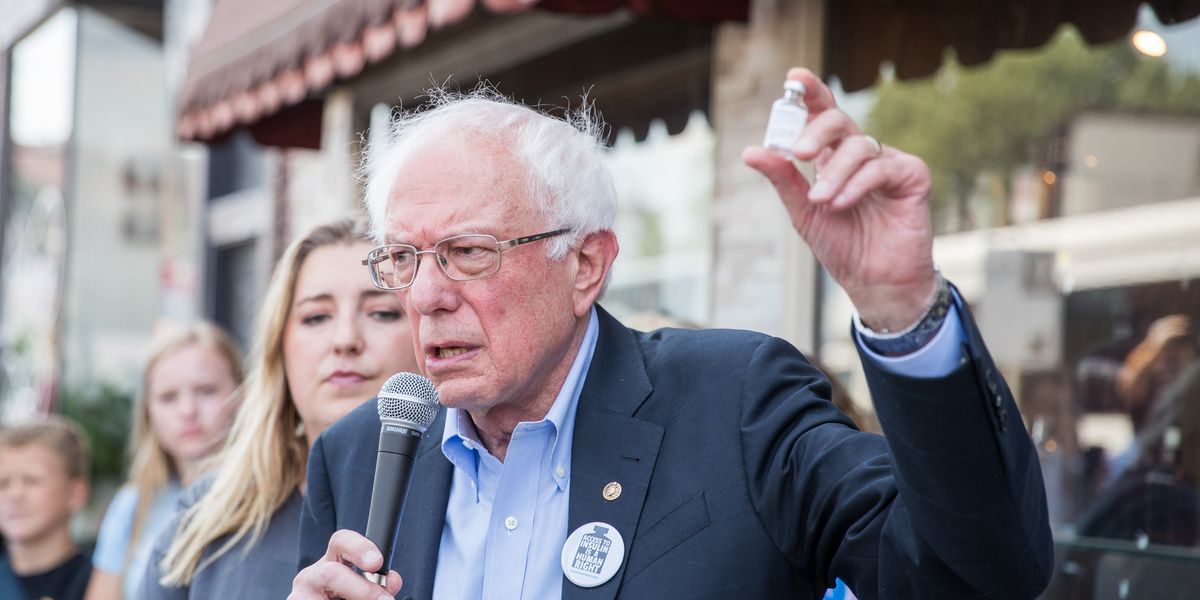
Crediting advocacy groups with pressuring two out of the three pharmaceutical companies that supply insulin to patients with diabetes in the United States to drastically lower their prices, Sen. Bernie Sanders on Tuesday called on the last of the trio, Sanofi, to do the same while arguing price caps should be mandatory—not a choice.
Novo Nordisk on Tuesday announced that it will cut prices by up to 75% for some of its insulin products starting next year, less than two weeks after one of its rival companies, Eli Lilly, said it plans to slash prices for its most widely used insulin products by 70%.
A vial of one of Novo’s products, NovoLog, will drop from more than $289 to just over $72, and the insulin product FlexPen will cost $139, down from more than $500, starting January 1, 2024.
The price changes come after the price of insulin for patients has more than tripled in recent decades, with deadly consequences for some of the eight million Americans who rely on synthetic insulin to convert food into energy. A study based on the 2021 National Health Interview Survey last November found that 1.3 million people in the U.S. rationed their insulin supply in 2021 due to the drug’s prohibitive cost.
Sanders (I-Vt.) noted that “grassroots pressure” forced Eli Lilly and Novo this month to announce major price cuts, but said that as chairman of the Senate Health, Education, Labor, and Pensions (HELP) Committee he “will soon hold a hearing on the need to guarantee insulin at an affordable price to everyone who needs it,” suggesting that voluntary price cuts by companies are not sufficient.
None— (@)Public pressure by groups including Patients for Affordable Drugs and Lower Drug Prices Now has resulted in some recent insulin price reforms, including a provision that took effect in January capping insulin copayments at $35 per month for Medicare recipients.
As Common Dreams reported last week, days after Eli Lilly announced its voluntary price cuts, Sanders, a longtime advocate of affordable insulin, joined Rep. Cori Bush (D-Mo.) in introducing legislation that would prohibit pharmaceutical companies from charging more than $20 for a vial of insulin. President Joe Biden has called for the product to be capped at $35 per vial for all patients—a proposal that Senate Republicans voted down last year.
Novo’s announcement, said Biden, “builds on the important progress we made last year when I signed a law to cap insulin at $35 for seniors. I urge all other manufacturers to follow suit and Republicans in Congress to join us and cap insulin at $35 for all Americans.”
Advocacy groups also called on Sanofi, the third insulin manufacturer for American patients, to follow its rival companies’ lead and introduce price cuts.
None— (@)“Let’s keep fighting,” said Lower Drug Prices Now, “so that patients can afford any medicine they need.”
This post was originally published on Common Dreams.
-

A progressive coalition of more than 100 unions and consumer advocacy groups from across the United States has come together to build the “Stop the Merger” campaign, a national and state-level effort to prevent Kroger from acquiring Albertsons and establishing the country’s most powerful grocery cartel.
On Tuesday, the coalition announced the launch of NoGroceryMerger.com, which includes information about the negative impacts of the proposed $25 billion merger between two of the nation’s largest grocery chains, testimony from unionized grocery workers and elected officials, and tools for people to express their opposition to the potential deal.
Individuals and organizations can sign the coalition’s letter to the Federal Trade Commission (FTC), which is currently reviewing the grocery giants’ proposal and has the regulatory authority to reject it.
If approved, the merger would likely “lead to store closures, worsen food deserts, increase prices for consumers, and destroy thousands of unionized grocery jobs,” the letter warns. “This deal is an antitrust travesty and it must be stopped.”
Since the Covid-19 pandemic and Russia’s invasion of Ukraine disrupted international supply chains—rendered fragile by decades of neoliberal globalization—Kroger, Albertsons, and other mega-grocers have capitalized on these crises as well as the bird flu outbreak, citing them to justify price hikes that far outpace the increased costs of doing business.
Such price gouging has been exacerbated by preceding rounds of supermarket consolidation, and the coalition warns that if the proposed merger between Kroger and Albertsons goes through, it “will no doubt create a monopoly in the grocery industry.”
Less competition, says the coalition, would result in even higher food prices and hundreds of shuttered stores—intensifying unequal access to healthy food. It also threatens to destroy thousands of jobs and hurt the ability of farmers and other suppliers to sell their products.
“It’s simple: This merger will be bad for workers, bad for customers, and bad for our communities.”
Cincinnati-based Kroger trails only Walmart in grocery sales, while Boise-based Albertsons is the fourth largest grocery chain in the U.S., behind Costco. Together, Kroger and Albertsons, including their numerous subsidiaries, employ more than 700,000 workers at roughly 5,000 retail stores and more than 50 manufacturing facilities across 48 states plus Washington, D.C.
According to the campaign’s fact sheet, “If this merger goes through, the resulting company will become the largest supermarket by revenue in the United States with a current national market share of 36% and a combined annual sales of more than $200 billion.”
As Michelle Freitas, a United Food and Commercial Workers (UFCW) Local 7 member who works at a Safeway in Gunnison, Colorado, noted: “My town only has two standalone grocery stores. If one closes and we only have one option, it will be a monopoly which means this new grocery company could raise food prices to exorbitant amounts.”
“If the prices for essential goods go up, how are people who are lower-income or middle-income going to be able to survive?” she asked. “Many people who work at my store live paycheck to paycheck, including parents with small children and single moms.”
Lawanna Archer, a UFCW Local 770 member who works at a Vons in Gardena, California, described the devastation that accompanied a merger between Albertsons and Haggen eight years ago.
“The deal between Albertsons and Haggen in 2015 was really bad for workers,” said Archer. “I saw massive layoffs, cars being repossessed, foreclosures, and loss of benefits. I am a single mother and I provide for my daughter and myself. The Kroger and Albertsons merger could possibly impact us in the most harmful way ever.”
Christina Robinett, another UFCW Local 770 member who endured that merger and now works at a Vons in Ojai, California, said, “After Haggen went bankrupt and shut down my store, I applied for work at four different stores.”
“I wasn’t able to get a job for three months and I had to take side jobs as a seamstress and cleaning houses to make ends meet,” she said. “That merger caused me a lot of anxiety. No worker should go through this kind of hardship again.”
The campaign’s website features several videos, including one in which Robert Reich, a professor at the University of California, Berkeley and former U.S. labor secretary, explains how the proposed merger “could send skyrocketing food prices through the stratosphere unless government sees the deal for what it is: a rotten egg.”
Soon after the proposed deal was announced in October, Sens. Bernie Sanders (I-Vt.) and Elizabeth Warren (D-Mass.) implored the FTC to block it.
Although consolidation in the grocery sector has, according to the American Economic Liberties Project, “previously been mismanaged by antitrust enforcers,” approval of Kroger’s buyout of Albertsons—the largest supermarket deal since Supervalu, CVS, and a group of investment firms bought Albertsons for $9.7 billion in 2006—is far from guaranteed.
Federal officials, including FTC Chair Lina Khan and Jonathan Kanter, assistant attorney general of the U.S. Department of Justice’s Antitrust Division, have both taken a more hard-nosed approach to mergers following decades of lax enforcement.
The decision before regulators should be easy, the coalition argues.
Its members have “written numerous letters to the FTC and state attorneys general, held meetings with federal and state elected officials and regulators, held press conferences and virtual town halls, attended public events on the merger hosted by government officials, and participated in various local community activities opposing the merger,” the coalition said in a statement. “All this activity has helped reveal growing evidence that shows the real motives for the proposed merger: corporate greed at the hands of C-suite executives and the private equity firms that are significant owners of their stock.”
“It’s simple: This merger will be bad for workers, bad for customers, and bad for our communities,” reads the campaign website. “Union grocery workers, consumers, elected officials, and community members are standing together to fight for access to nutritious food, safe shopping experiences, and investment in good jobs in our communities.”
This post was originally published on Common Dreams.
-
A Senate Democrat introduced two bills on Thursday that would chip away at the major advantage that employers hold in union campaigns and disputes by tweaking tax laws. One bill, the No Tax Breaks for Union Busting Act, would bar companies from writing off union busting expenses as business expenses on their taxes, ending taxpayer subsidization of union busting, as a press release on the bill puts…
This post was originally published on Latest – Truthout.
-
Sen. Bernie Sanders (I-Vermont) introduced a bill on Thursday that takes a crack at ending a crisis that has long plagued the U.S. education system: extremely low teacher pay. Sanders, the chair of the Senate Health, Education, Labor and Pensions Committee, has proposed setting a nationwide minimum wage for teachers at $60,000 a year. This would raise the salaries of 43 percent of public school…
This post was originally published on Latest – Truthout.
-
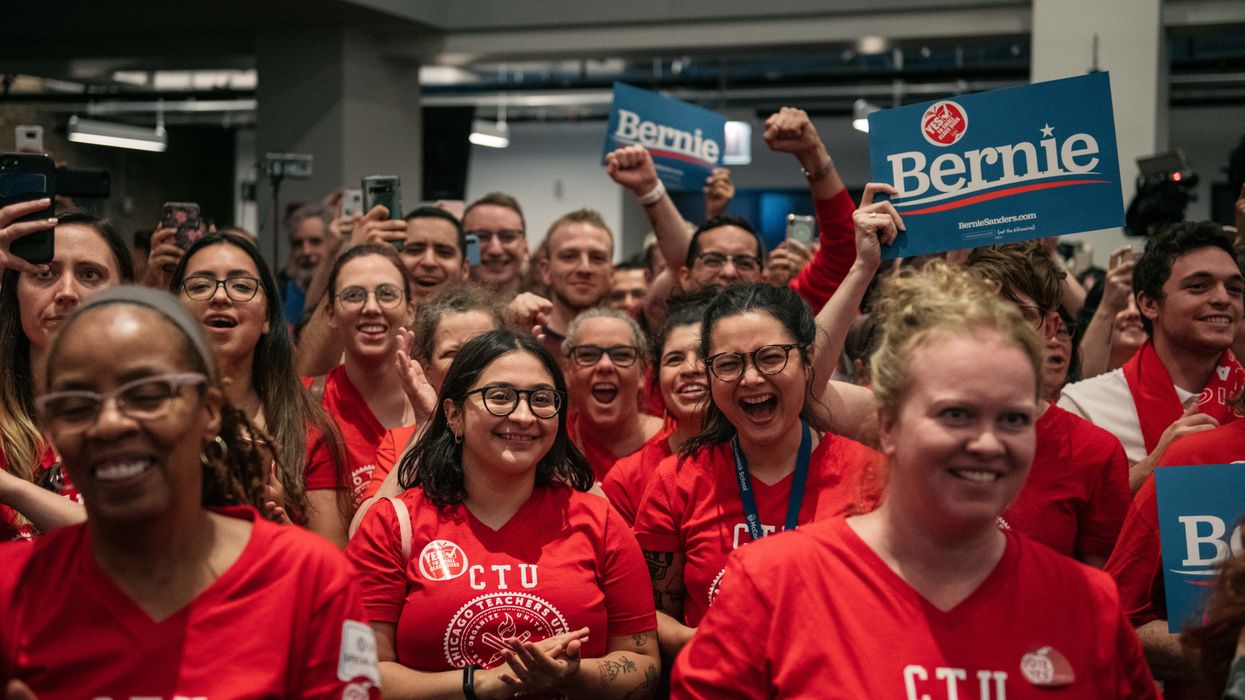
Demanding an end to “the international embarrassment” of low teacher pay in the United States, U.S. Sen. Bernie Sanders on Thursday introduced legislation to guarantee a minimum salary for public school educators of $60,000 per year, moving to fulfill a pledge he made during his 2020 presidential campaign.
The Vermont Independent senator called on the federal government to take accountability for chronic staffing shortages in school districts across the country, which he said is linked to the fact that “the starting pay for teachers in almost 40% of our nation’s school districts is less than $40,000 a year” and that the average weekly wage of a public school teacher has gone up by just $29 in the past 30 years, adjusting for inflation.
More than half of the nation’s schools are understaffed, according to the National Center on Education Statistics, and Sanders noted in a fact sheet about his proposal that “hundreds of thousands of public school teachers have to work two or three jobs during the school year to make ends meet.” A recent report by the Teacher Salary Project found that 17% of educators work part-time in retail, restaurants, or in the gig economy to supplement their meager incomes.
Sanders, who chairs the Senate Health, Education, Labor, and Pensions Committee, called the statistic “simply unacceptable.”
None— (@)“The situation has become so absurd that the top 15 hedge fund managers on Wall Street make more money in a single year than every kindergarten teacher in America combined—over 120,000 teachers,” said the senator. “Wages for public school teachers are so low that in 36 states, the average public school teacher with a family of four qualifies for food stamps, public housing, and other government assistance programs. We have got to do better than that.”
The Pay Teachers Act of 2023 would significantly increase investments in public education, beyond teacher salaries—tripling Title I-A funding for schools with high percentages of low-income students and funding for rural education programs; providing an additional $1 billion for the Bureau of Indian Education; and investing in grant programs to improve teacher preparation and development, among other investments.
States would be required to establish a “minimum salary for teachers” of at least $60,000 per year, with increases throughout their career, and to ensure teachers are paid “a livable and competitive annual salary” that’s comparable to professionals with similar education requirements.
“Educators are nation builders,” said Randi Weingarten, president of the American Federation of Teachers, which represents 1.7 educators. “They have a vital role in educating and caring for our next generation. But they are neither treated nor paid commensurate with that role. Teachers earn nearly 24% less than similarly educated professionals, and when adjusted for inflation, many [earn] less than they were making a decade ago.”
“Even with their need to take second jobs, educators spend hundreds of thousands of dollars on supplies, snacks, books, and other items for students,” she added. “Chairman Bernie Sanders’s bill, the Pay Teachers Act, will help close the pay gap by significantly increasing federal investments in public schools and raising annual teacher salaries.”
Co-sponsors of the Pay Teachers Act include Democratic Sens. Mazie Hirono of Hawaii, Ben Ray Luján of New Mexico, Ed Markey of Massachusetts, Jeff Merkley of Oregon, Alex Padilla of California, Elizabeth Warren of Massachusetts, and Peter Welch of Vermont.
Ellen Sherratt, board president of the Teacher Salary Project, applauded the legislation and lawmakers who are”fighting for teacher salary levels that are professional.”
None— (@)Sanders introduced the legislation a month after holding a town hall with labor leaders and teachers from across the country regarding chronic low pay in the field, where educators talked about completing hours of work per week outside of the school day for no extra pay, purchasing snacks for low-income students, and facing barriers to working in schools that have many open teaching positions and have resorted to hiring people without teaching qualifications.
“Students of every color, background, and ZIP code deserve qualified and caring educators who are dedicated and have the resources to uncover the passions and potential of every child,” said Becky Pringle, president of the National Education Association (NEA), as Sanders introduced the bill Thursday. “America’s schools are facing a five-alarm crisis because of the educator shortages that have been decades in the making and exacerbated by the pandemic. Together, we must recruit large numbers of diverse educators into the profession and retain qualified and experienced educators in our schools to support our students in learning recovery and thriving in today’s world. To do that, we must have competitive career-based pay to recruit and retain educators.”
“On behalf of the three million members of the National Education Association, I thank Chairman Sanders for introducing the Teacher Pay Act,” she added. “We urge senators to support educators and cosponsor this commonsense legislation that invests in our students, educators, and public schools.”
This post was originally published on Common Dreams.
-
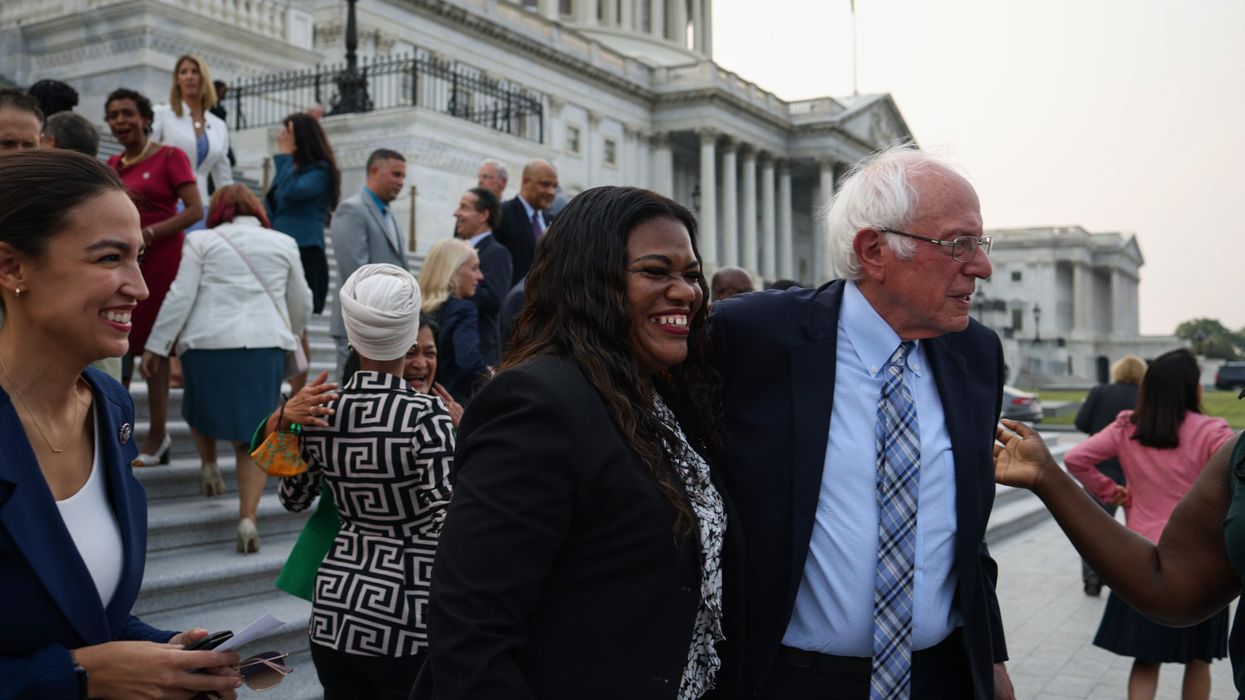
Sen. Bernie Sanders and Rep. Cori Bush on Thursday introduced legislation that would prohibit pharmaceutical companies from charging more than $20 for a vial of insulin, a move that comes a week after Eli Lilly pledged to cap out-of-pocket payments for its insulin products at $35 per month.
“As a nurse, I’ve seen too many people in our communities struggle to afford their lifesaving insulin medication,” Bush (D-Mo.) said in a statement. “People are left choosing between insulin or groceries; insulin or rent; insulin or child care. This is unacceptable.”
More than 7 million people across the U.S. use insulin to manage their diabetes, and some have been forced to pay upwards of $1,000 per month for the medicine as pharmaceutical giants have jacked up prices with abandon in recent decades.
According to one study published in October, more than a million people in the U.S. have had to ration insulin due to the high cost.
Sanders (I-Vt.), the chair of the Senate Health, Education, Labor, and Pensions Committee and a longtime advocate of insulin price reform, said Thursday that “there is no reason why Americans should pay the highest prices in the world for insulin—in some cases, ten times as much as people in other countries.”
“In 1923, the inventors of insulin sold their patents for $1 to save lives, not to turn pharmaceutical executives into billionaires,” said Sanders. “Now, 100 years later, unacceptable corporate greed has caused the price of this lifesaving medication to skyrocket by over 1,000% since 1996. We can no longer tolerate a rigged healthcare system that forced 1.3 million people with diabetes to ration insulin while the three major insulin manufacturers made $21 billion dollars in profits.”
“Now is the time for Congress to take on the greed and power of the pharmaceutical industry and substantially lower the price of insulin,” the senator added. “In the richest country in the history of the world, no one should die because they cannot afford the medication they need.”
If passed, the Insulin for All Act of 2023 would cap the list price of insulin nationwide at “$20 per 1000 units… which may be contained in one or more vials, pens, cartridges, or other forms of delivery.”
Original co-sponsors of the legislation include Sen. Ed Markey of Massachusetts, Reps. Jamaal Bowman and Alexandria Ocasio-Cortez of New York, Rep. Rashida Tlaib of Michigan, and Sen. Jeff Merkley of Oregon.
“Big Pharma continues to rake in record profits by gouging patients on insulin prices,” Merkley said in a statement. “Unaffordable high prices are forcing patients to ration their insulin, leading to dire health consequences—heart attacks, stroke, blindness, kidney failure, foot disease and amputations, even death. It’s tragic, it’s unacceptable, and it’s time to end this rip-off.”
The new bill is also backed by more than 70 advocacy organizations, including T1International, Public Citizen, and Social Security Works.
“This bill being called the Insulin for All Act of 2023 shows the power of grassroots activism,” said Elizabeth Pfiester, a patient with Type 1 diabetes and the founder and executive director of T1International, the group behind the #insulin4all campaign.
“We know that Eli Lilly isn’t lowering the list price of one of their insulins out of the goodness of their hearts,” Pfiester added. “That’s why policy change to ensure patients with diabetes can’t be exploited anymore is essential.”None— (@)Eli Lilly’s decision earlier this month to slash the prices of its most-prescribed insulin products by 70% was cautiously welcomed by advocates who have been organizing against insulin price gouging for years.
But campaigners stressed that given the serious limitations of Eli Lilly’s pledge—and the company’s ability to raise prices again whenever it chooses—federal action is still necessary to ensure lower costs for everyone, including those who use products made by the other two giant insulin manufacturers, Sanofi and Novo Nordisk.
The three companies produce more than 90% of the global insulin supply, market dominance that has allowed them to drive up costs massively—drawing legal action from several U.S. states, including California.
Last April, Human Rights Watch released a report showing that Eli Lilly has raised the list price of Humalog by an inflation-adjusted 680% since it first began selling the product in the late 1990s. The company vowed earlier this month to slash the list price of Humalog by 70% starting in the fourth quarter of this year.
This post was originally published on Common Dreams.
-
Democrats and progressives in Congress reintroduced a bill on Tuesday that would ban the government from using facial recognition technology as increasing surveillance and police violence pose a threat to marginalized communities. The bill would also prevent the government from using biometric technologies like voice and gait recognition, while providing individuals a legal pathway against having…
-
Starbucks CEO Howard Schultz has agreed to testify before the Senate labor committee after committee chair Sen. Bernie Sanders (I-Vermont) threatened to subpoena the executive to appear in a hearing on the company’s rampant union busting later this month. Sanders announced the company’s decision on Tuesday after weeks of demurring from the company, thanking members in the committee for being…
This post was originally published on Latest – Truthout.
-

An analysis published Monday by the watchdog Accountable.US revealed that the biggest oil companies operating in the United States raked in a collective $290 billion in profits last year while they “consistently prioritized shareholder returns over alleviating the pressure of high energy prices.”
According to the report—which analyzed 26 oil companies doing business in the U.S.—the $290 billion in collective 2022 Big Oil profits marked a 126% increase from the previous year. Fossil Fuel giants including BP, Shell, and Chevron more than doubled their net income in 2022, while smaller players like Murphy Oil And Southwestern Energy saw respective increases of 1,410% and 7,496%.
“With $290 billion in profits, Big Oil made enough money in 2022 to end world hunger, pay off U.S. medical debt, and build 10 Disney Worlds, but instead used their record profits to shower $163 billion on shareholders with plans to give even more in 2023,” Accountable.US said.
\u201cIn 2022, Big Oil giants like @Shell, @BP_America and @ExxonMobil doubled their profits and added billions to their shareholders’ pockets by gouging American consumers.\n\nLearn how their profiteering kept prices high at the pump: https://t.co/njDbQo9E9c\u201d— Accountable.US (@Accountable.US)
1678133351According to a summary of the analysis:
The industry’s historic margins were largely achieved through unabated price gouging of American consumers. As families across the country experienced financial strain due to the artificially high prices at the pump, the industry spent over $163 billion on stock buybacks and dividends, further enriching their wealthy shareholders. Even as Big Oil executives complain about supposedly lower-than-desired margins in 2023, oil and gas companies have already publicly announced plans to buy at least $160 billion in stock backs starting this year.
“Modern-day oil barons like Shell, BP, and Chevron forced American consumers into financial strain and ruthlessly extracted every last dime out of working and middle-class people,” said Accountable.US director of energy and environment Jordan Schreiber.
Fossil fuel and other corporations have used the Covid-19 pandemic, Russia’s invasion of Ukraine, and inflation as pretexts to price gouge consumers.
“Despite the industry’s bald-faced lies, Big Oil’s never-ending greed was the central force driving the industry’s obscene price gouging,” Schreiber continued. “Now, executives have already announced plans to spend $160 billion on stock buybacks to enrich their wealthy shareholders further.”
“Meanwhile,” she added, “the MAGA majority in the House continues to shield Big Oil from accountability as their constituents pay the price.”
Last March, Rep. Ro Khanna (D-Calif.) introduced a bill that would tax excess oil company profits and pay American households a quarterly refund. That same month, Sen. Bernie Sanders (I-Vt.) introduced the Ending Corporate Greed Act, a proposed 95% windfall profits tax on major oil companies.
While President Joe Biden has threatened to support a windfall profits tax on oil companies if they don’t increase production, he has not yet done so.
-

An analysis published Monday by the watchdog Accountable.US revealed that the biggest oil companies operating in the United States raked in a collective $290 billion in profits last year while they “consistently prioritized shareholder returns over alleviating the pressure of high energy prices.”
According to the report—which analyzed 26 oil companies doing business in the U.S.—the $290 billion in collective 2022 Big Oil profits marked a 126% increase from the previous year. Fossil Fuel giants including BP, Shell, and Chevron more than doubled their net income in 2022, while smaller players like Murphy Oil And Southwestern Energy saw respective increases of 1,410% and 7,496%.
“With $290 billion in profits, Big Oil made enough money in 2022 to end world hunger, pay off U.S. medical debt, and build 10 Disney Worlds, but instead used their record profits to shower $163 billion on shareholders with plans to give even more in 2023,” Accountable.US said.
\u201cIn 2022, Big Oil giants like @Shell, @BP_America and @ExxonMobil doubled their profits and added billions to their shareholders’ pockets by gouging American consumers.\n\nLearn how their profiteering kept prices high at the pump: https://t.co/njDbQo9E9c\u201d— Accountable.US (@Accountable.US) 1678133351According to a summary of the analysis:
The industry’s historic margins were largely achieved through unabated price gouging of American consumers. As families across the country experienced financial strain due to the artificially high prices at the pump, the industry spent over $163 billion on stock buybacks and dividends, further enriching their wealthy shareholders. Even as Big Oil executives complain about supposedly lower-than-desired margins in 2023, oil and gas companies have already publicly announced plans to buy at least $160 billion in stock backs starting this year.
“Modern-day oil barons like Shell, BP, and Chevron forced American consumers into financial strain and ruthlessly extracted every last dime out of working and middle-class people,” said Accountable.US director of energy and environment Jordan Schreiber.
Fossil fuel and other corporations have used the Covid-19 pandemic, Russia’s invasion of Ukraine, and inflation as pretexts to price gouge consumers.
“Despite the industry’s bald-faced lies, Big Oil’s never-ending greed was the central force driving the industry’s obscene price gouging,” Schreiber continued. “Now, executives have already announced plans to spend $160 billion on stock buybacks to enrich their wealthy shareholders further.”
“Meanwhile,” she added, “the MAGA majority in the House continues to shield Big Oil from accountability as their constituents pay the price.”
Last March, Rep. Ro Khanna (D-Calif.) introduced a bill that would tax excess oil company profits and pay American households a quarterly refund. That same month, Sen. Bernie Sanders (I-Vt.) introduced the Ending Corporate Greed Act, a proposed 95% windfall profits tax on major oil companies.
While President Joe Biden has threatened to support a windfall profits tax on oil companies if they don’t increase production, he has not yet done so.
This post was originally published on Common Dreams.
-
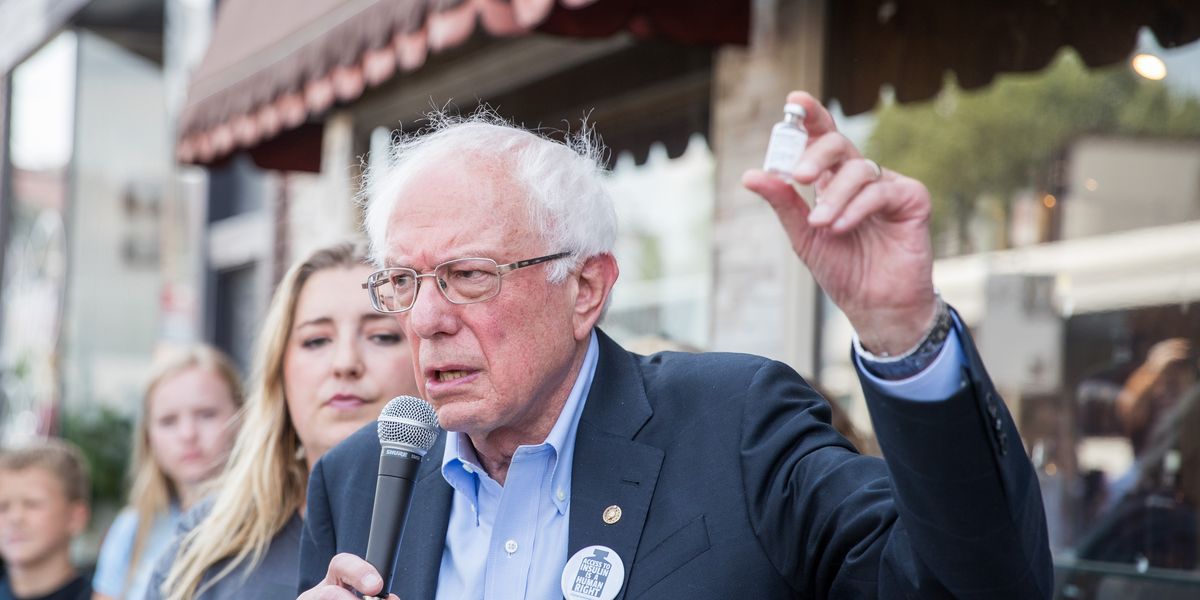
Sen. Bernie Sanders on Wednesday announced plans to introduce legislation that would cap U.S. insulin prices at $20 per vial after Eli Lilly pledged to cut the list prices of its most commonly used insulin products by 70%.
Sanders (I-Vt.), the chair of the Senate Health, Education, Labor, and Pensions Committee, said in a statement that “this is what fighting back accomplishes” and urged two other major insulin manufacturers to replicate Eli Lilly’s move, which also includes capping monthly out-of-pocket insulin payments at $35 for many people with diabetes.
“At a time when Eli Lilly made over $7 billion in profits last year, public pressure forced them to reduce the price of insulin by 70%,” said the Vermont senator. “Now is the time for Sanofi and Novo Nordisk to do the same. Now is the time to end the greed of the pharmaceutical industry and substantially lower the outrageous cost of prescription drugs in America.”
In letters to the CEOs of Sanofi and Novo Nordisk—which together with Eli Lilly produce more than 90% of the global insulin supply—Sanders wrote that “people with diabetes should not be forced to pay $98 for a vial of insulin that costs just $8 to manufacture and can be purchased in Canada for just $12.”
“I urge you to join Eli Lilly in substantially lowering the price your company charges for insulin and make certain that all Americans can purchase this lifesaving drug,” added the senator, who has been scrutinizing the trio’s business practices—including price collusion—for years.
“Let’s be clear: Insulin is not a new drug,” Sanders continued. “It was discovered 100 years ago by Canadian scientists who sold the patent rights of insulin for just $1 because they wanted to save lives, not make pharmaceutical executives extremely wealthy. And yet, as a result of unacceptable corporate greed, the price of insulin has gone up by over 1,000% since 1996, causing 1.3 million people with diabetes to ration insulin last year while your companies made billions of dollars in profits. That is absolutely unacceptable.”
\u201cPublic pressure forced Eli Lilly to reduce the price of insulin by 70%. Today, I sent a letter demanding Sanofi and Novo Nordisk do the same. Now is the time to end the greed of the pharmaceutical industry and substantially lower the outrageous cost of prescription drugs.\u201d— Bernie Sanders (@Bernie Sanders) 1677710196Eli Lilly’s announcement was welcomed as a victory for people with diabetes who have been campaigning tirelessly for years to bring down insulin prices in the U.S., where some patients have been forced to pay more than $1,000 a month for the lifesaving medicine.
But the company’s move also drew skepticism as advocates remain wary of the limitations of Wednesday’s pledge and of Eli Lilly’s commitment to keeping prices low, particularly given the pharmaceutical giant’s history of lobbying against efforts to rein in prescription drug costs.
In a footnote at the bottom of its Wednesday press release, Eli Lilly states that “government restrictions exclude people enrolled in federal government insurance programs from Lilly’s $35 solutions.”
People on Medicare are covered by the Inflation Reduction Act’s $35-per-month cap on insulin copayments, but low-income people on Medicaid don’t appear to be eligible for Eli Lilly’s price-cap program.
Additionally, Eli Lilly’s 70% price cut for Humalog—the company’s most commonly prescribed insulin product—won’t take effect until the fourth quarter of this year, “giving Lilly seven more months of high prices even as they are lauded for their corporate responsibility,” noted The American Prospect‘s Robert Kuttner.
“And since Lilly caps out-of-pocket costs to patients but not necessarily prices charged to insurance companies,” Kuttner added, “the result could be cost-shifting and higher insurance premiums.”
Such caveats led campaigners to emphasize the necessity of federal action to guarantee that insulin is available and affordable for all who need it.
“Insulin manufacturers have shown time and time again that they will put their CEOs’ profits over patients’ lives,” said Kristen Whitney Daniels, the co-leader of T1International’s federal working group and a person living with Type 1 diabetes. “That’s why the government also needs to regulate insulin manufacturers to hold them accountable to ensuring the human right to insulin.“
This post was originally published on Common Dreams.
-
Rep. Mark Takano is planning to introduce a proposal that would shorten the standard work week in the U.S. to four days as the idea gains traction in Washington. Takano, a Democrat from California, is planning to reintroduce a bill that would amend the Fair Labor Standards Act to establish a standard work week that is 32 hours rather than 40, amounting to four eight-hour workdays.
This post was originally published on Latest – Truthout.
-
Senate Health, Education, Labor and Pensions (HELP) Committee Chair Bernie Sanders (I-Vermont) announced on Wednesday that he is setting up a vote on subpoenaing Starbucks CEO Howard Schultz after Schultz refused Sanders’s request to testify about the company’s rampant union busting last month. Sanders said that Schultz’s avoidance of the request has “given us no choice but to subpoena him” and…
-
On Tuesday, Sen. Bernie Sanders (I-Vermont) and Representatives Bobby Scott (D-Virginia) and Brian Fitzpatrick (R-Pennsylvania) put forth a sweeping pro-labor bill that has been hailed as one of the most crucial pieces of legislation for the labor movement in the modern era of union busting. With the support of nearly 200 cosponsors in the House and Senate, the lawmakers reintroduced the Richard L.
This post was originally published on Latest – Truthout.
-
Senators Bernie Sanders (I-Vermont) and Elizabeth Warren (D-Massachusetts) delivered fiery speeches in favor of student debt cancellation on the steps of the Supreme Court on Tuesday as justices heard oral arguments challenging President Joe Biden’s groundbreaking debt forgiveness plan. Joining over 500 students, debtors and advocates in a rally organized by the Student Borrower Protection Center…
-
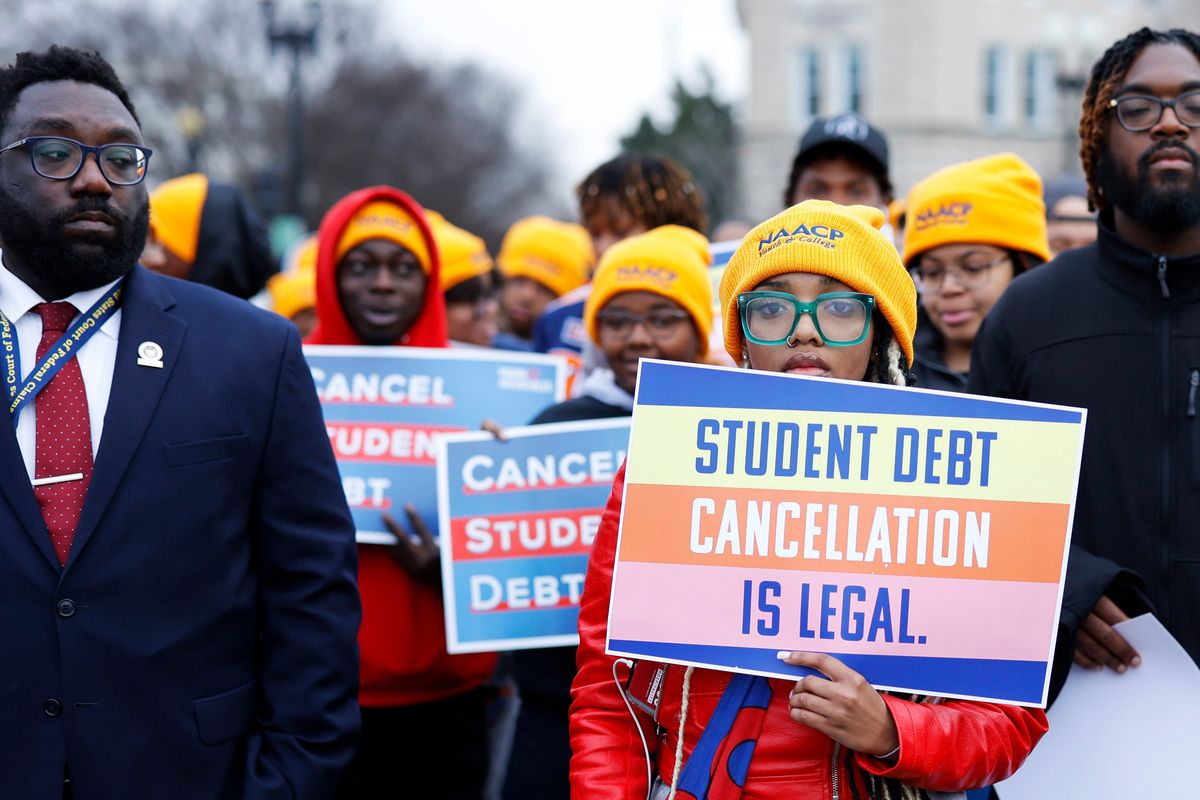
Borrowers, advocates, and lawmakers converged on the steps of the U.S. Supreme Court on Monday night and Tuesday morning to defend President Joe Biden’s stalled student debt relief plan as justices prepared to consider a pair of right-wing challenges to the popular proposal.
Attendees argued that Biden’s move to erase up to $20,000 in student debt for federal borrowers with individual incomes under $125,000 and modify the income-driven repayment program is just, legal, and necessary. Although it falls short of progressives’ demands for universal cancellation, speakers made clear that the White House’s plan is key to improving economic security.
“You should not have to face financial ruin because you want a damn education!” Sen. Bernie Sanders of Vermont said during Tuesday morning’s rally. “Education, from child care to graduate school, is a human right. It should be free to all.”
“Today we say to the Supreme Court, listen to the needs of millions of struggling people,” Sanders added. “Do the right thing. Support Biden’s proposal to cancel student debt.”
“President Biden’s executive authority to provide student debt relief to borrowers is abundantly clear.”
After Monday night’s rally, some campaigners planned to camp out overnight in a bid to secure seats in the courtroom for Tuesday’s oral arguments, which began at 10:00 am ET.
In both Biden v. Nebraska—brought by the Republican-led states of Nebraska, Missouri, Arkansas, Iowa, Kansas, and South Carolina—and Department of Education v. Brown—filed with the support of billionaires by a pair of plaintiffs who claim they were unfairly excluded from relief—the right-wing-controlled Supreme Court will decide whether Biden’s plan exceeds the U.S. Department of Education’s (DOE) authority and whether the lawsuits have legal standing.
In a Tuesday statement released ahead of the hearing, Democratic Rep. Cori Bush of Missouri said, “Today, far-right Republican attorneys general will bring baseless and politically motivated arguments to the Supreme Court in opposition to providing student debt relief promised to 40 million borrowers across our country.”
“Regardless,” said Bush, “President Biden’s executive authority to provide student debt relief to borrowers is abundantly clear—just look at the facts.”
Bush continued:
Fact: The basis of the Republican AG’s case relies on the claim that this relief plan threatens the profits of loan servicers such as MOHELA and states will be financially injured. Yet, in response to an October letter I sent to MOHELA, they denied involvement in the case and discredited Republicans by stating that they don’t operate to make profits and remain committed to complying with contractual obligations set forth by the U.S. Department of Education.
Fact: Republicans claim that states, like Missouri, also rely on revenue from loan servicers like MOHELA. Yet, MOHELA hasn’t paid their bills to the state in over a decade and owes over $100 million to the state of Missouri.
Fact: President Biden’s student debt relief plan would provide 40 million borrowers across our country—including 144,000 of my constituents—with life-changing financial relief. Following the economic devastation of the pandemic, we need transformative policy solutions to foster an equitable economic recovery.
“I know what it’s like to carry crushing student debt and to have to make impossible choices between paying rent or paying an exorbitant student loan bill,” said Bush. “And I’ve heard from people across the country who have shared how this relief would change their lives—from being able to afford child care, to paying their medical bills, to being able to put food on the table.”
“The facts are clear, and I implore the Supreme Court to affirm the president’s executive authority to cancel up to $20,000 in student debt,” she added. “I’m confident the Biden-Harris administration’s plan will withstand these hurdles and provide the much-needed relief to borrowers.”
Right-wing lawmakers and activists filed numerous lawsuits after the White House announced its student debt cancellation bid in August. Applications for relief closed in November after a federal judge appointed by former President Donald Trump blocked Biden’s plan. At the time, 26 million borrowers had already applied for or were automatically eligible for relief, and 16 million applications were given the green light and sent to loan servicers.
While GOP members of Congress argue that student debt relief is a regressive policy whose benefits would flow disproportionately to wealthy households, DOE data released earlier this month dispels that myth. According to a Politico analysis of the data, over 98% of people who applied before the portal was frozen reside in ZIP codes where the average per-capita income is under $75,000. Nearly two-thirds of applicants live in neighborhoods where the average person makes less than $40,000 per year.
With his relief initiative on hold, Biden extended the pause on federal student loan repayments—a measure that was introduced at the beginning of the Covid-19 pandemic in March 2020 and had been set to expire on December 31, 2022—through June 30, 2023. Payments are set to restart 60 days after that date, or 60 days after the high court hands down its decision, whichever comes first.
The Debt Collective, however, tweeted Monday night: “We’re not paying that damn student debt no matter what the Supreme Court and its corrupted judges say.”
This post was originally published on Common Dreams.
-
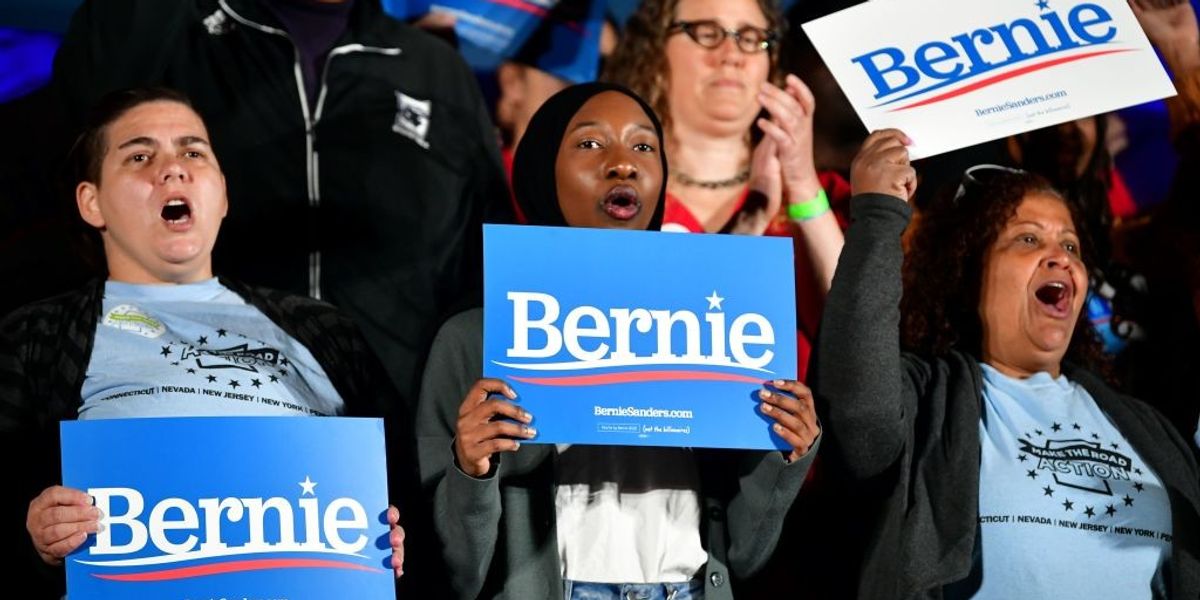
To understand the current fierce attacks on the progressive leadership of the Nevada Democratic Party, it’s helpful to recall the panicked reaction from political elites three years ago when results came in from the state’s contest for the presidential nomination. Under the headline “Moderates Hustle to Blunt Sanders’ Momentum After Nevada Win,” the Associated Press reported that “Bernie Sanders’ commanding Nevada caucus victory made him a top target for his Democratic rivals and a growing source of anxiety for establishment Democrats.”
Such anxiety spiked for Nevada’s establishment Democrats a year later, in early March 2021, when a progressive slate, headed by activist Judith Whitmer, won every officer seat in the state party, stunning its entrenched leaders. As she explained at the time, “what they just didn’t expect is that we got better and better at organizing and out-organizing them at every turn.”
At the eleventh hour, seeing the progressive writing on the wall, the sore losers-to-be had siphoned $450,000 out of the state party’s treasury, transferring the loot to the Democratic Senatorial Campaign Committee, safely under the control of corporate-aligned operatives. And when Whitmer’s victory became clear, all the employees of the Nevada Democratic Party greeted the newly elected chair by immediately quitting.
Bloviating predictions of disaster quickly ensued. But Nevada’s Catherine Cortez Masto, widely seen as the nation’s most vulnerable Democrat in the Senate, won re-election last November. So did each Democratic member of the U.S. House. And Democrats control both chambers of the state legislature. (The only major loss was the governor’s seat.) Whitmer cites nearly 2 million “direct voter contacts,” increased rural turnout and “wins in deep red territories.”
With her two-year term as state party chair about to expire, Whitmer is running for re-election as part of a progressive slate, while old-guard forces ousted by party delegates two years ago are on the attack under the banner of the ironically named “Unity Slate.” The Nevada Democratic Party’s central committee will vote on March 4.
The Unity Slate candidates “work for corporations and Republican-backed lobbyists,” Whitmer said, adding that if elected “the Unity Slate would work in an echo chamber to only serve the most funded politicians in our state, and only support the status quo’s agenda.”
The Unity Slate’s corporate ties are underscored by sponsors of its Sapphire PAC, which recently reported taking donations totaling $10,000 from Southwest Gas as well as $5,000 from NV Energy. Whitmer charged that acceptance of such funding from utility corporations “screws over the same voters we’re working hard to fight for as the so-called Unity Slate turns a blind eye to rising costs that impact our community’s most vulnerable.”
Whitmer said on Monday that her opponents “have the audacity and brazenness to run a registered lobbyist” on their Unity Slate as the candidate for second vice chair of the state party. She added that he “lobbies for an anti-union company fighting against our largest hardest-working union,” referring to the Culinary Union — which days ago “tweeted against his company,” the lobbying law firm Brownstein Hyatt Farber Schreck.
Nationally, Whitmer has been a leader in efforts to reform the Democratic National Committee. In early February, the DNC resolutions committee refused to act on a motion she co-authored to ban dark money in party primaries. “Time and time again, we’ve watched ‘dark money’ used to silence the voices our party most needs to hear,” Whitmer said. When “strong Democratic candidates willing to speak truth to power” have messages that “can be drowned out in a flood of untraceable expenditures,” she pointed out, “many candidates are questioning why they should even run.”
Three years ago, during the leadup to the hard-fought Nevada caucuses for delegates in the presidential nomination race, the wide gap between powerful union officials and rank-and-file workers was thrown into sharp relief. The hierarchy of the powerful Las Vegas-based Culinary Workers Union bashed Bernie Sanders for championing Medicare for All, but workers and their families overwhelmingly voted for Sanders. Now, the state AFL-CIO leadership is backing the “unity” slate against progressives.
The Nevada showdown comes right after notable progressive breakthroughs this winter in two other western states: Shasti Conrad won election to become chair of the Washington Democratic Party. Yolanda Bejarano, a leader of Communications Workers of America and a member of Progressive Democrats of America, won election to chair the Arizona Democratic Party.
Methodical organizing at the grassroots makes such progress possible. That’s what happened in West Virginia, where last summer activists wrested control of the state Democratic Party away from Joe Manchin, the archetypal big-money-talks Democratic senator.
Now, powerful forces are doing all they can to prevent the re-election of Judith Whitmer as chair of the Nevada Democratic Party. It’s a classic battle between top-down corporate money and bottom-up progressive activism.
This post was originally published on Common Dreams.
-
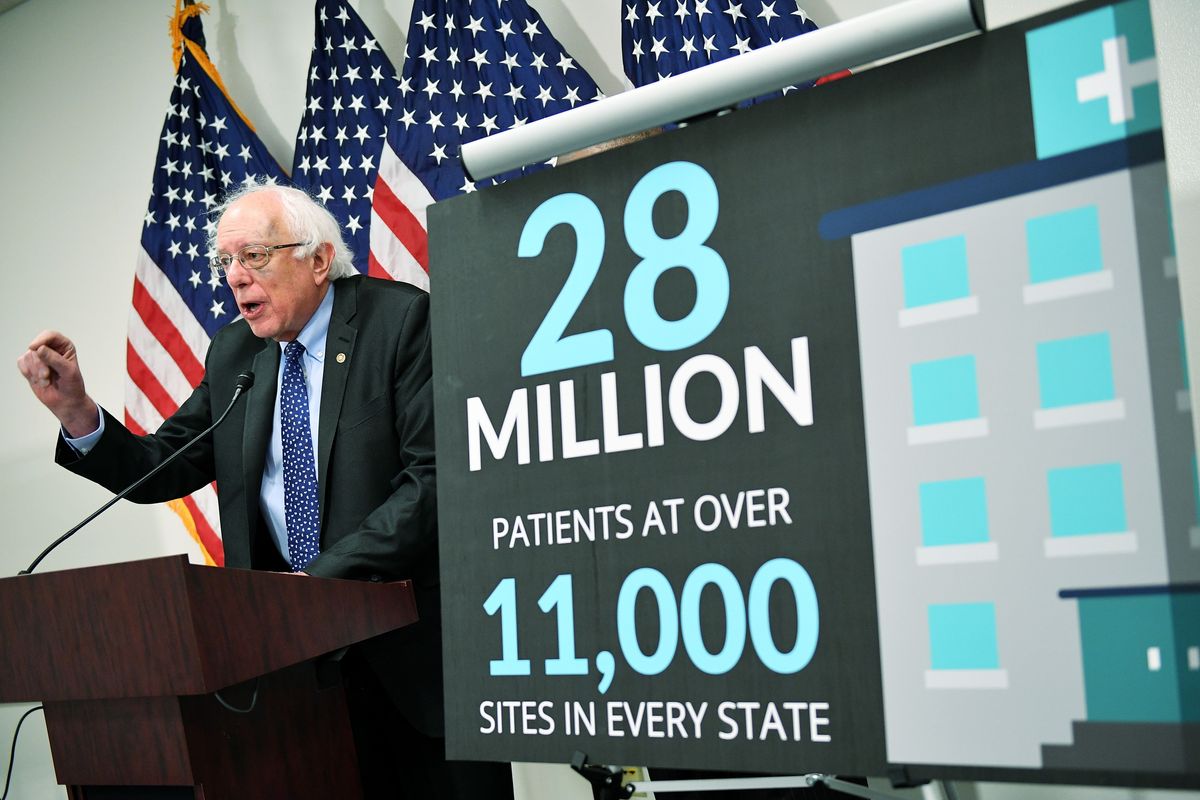
Sen. Bernie Sanders warned Monday that without swift congressional action, the $5.8 billion in federal funding relied on each year by community health centers around the United States will expire on September 30, resulting in a devastating “primary care cliff.”
“Congress can and must avoid” such a scenario, says a statement from the Vermont Independent’s office.
Sanders announced that the Senate Health, Education, Labor, and Pensions (HELP) Committee he chairs is scheduled to hold a hearing this Thursday at 10:00 am ET titled, “Community Health Centers: Saving Lives, Saving Money.”
Millions of people in the U.S. currently receive lifesaving services from community health centers in thousands of neighborhoods nationwide.
“In America today, community health centers are providing cost-effective primary medical care, dental care, mental health counseling, and low-cost prescription drugs to 30 million people regardless of a person’s bank account or insurance status,” said Sanders.
“Not only do these health centers save lives and ease human suffering,” Sanders continued. “They save Medicare, Medicaid, and our entire healthcare system billions of dollars each year because they avoid the need to go to expensive emergency rooms and hospitals.”
“In the midst of a broken and dysfunctional healthcare system, I will be doing everything I can to expand community health centers so that every American has access to the primary care that they need and deserve,” he added.
According to the senator’s office:
Nearly 100 million Americans live in a primary care desert, nearly 70 million live in a dental care desert, and some 158 million Americans—nearly half the country’s population—live in a mental healthcare desert. Today, 85 million people are uninsured or under-insured, over 500,000 people go bankrupt each year because of medically related debt, and more than 68,000 people die each year because they cannot afford the healthcare they desperately need. Expanding community health centers will begin to address this urgent crisis.
The following individuals are scheduled to testify at the hearing: Amanda Pears Kelly, chief executive officer of Advocates for Community Health and executive director of the Association of Clinicians for the Underserved; Ben Harvey, chief executive officer of Indiana Primary Health Care Association; Robert Nocon, assistant professor at Kaiser Permanente Bernard J. Tyson School of Medicine; Sue Veer, president and chief executive officer of Carolina Health Centers; and Jessica Farb, managing director at the Government Accountability Office.
This post was originally published on Common Dreams.
-
Sen. Elizabeth Warren (D-Massachusetts) and Bernie Sanders (I-Vermont) have raised concerns that pharmaceutical giant Merck’s request to extend the patent for a top cancer drug could represent another move from Big Pharma to abuse the patent system and maintain a monopoly on a life-saving drug. The lawmakers are urging the U.S. Patent and Trademark Office to scrutinize Merck’s application for new…
This post was originally published on Latest – Truthout.
-
As the Israeli government, run by far right Prime Minister Benjamin Netanyahu, advances even further in its violence and inhumanity against Palestinians, Sen. Bernie Sanders (I-Vermont) is calling for the U.S. to attach strings to its aid to Israel in order to combat the country’s suppression of Palestine. Speaking with CBS News this week, Sanders said that it is unacceptable for the U.S.
This post was originally published on Latest – Truthout.
-
Sen. Bernie Sanders (I-Vermont) is calling for the standard work week to be shortened from five to four days. On Twitter on Tuesday, Sanders said that technological advancements allow for less labor from workers, but are currently only used to pad the pockets of corporate executives. “With exploding technology and increased worker productivity, it’s time to move toward a four-day work week with no…
This post was originally published on Latest – Truthout.
-

Bernie Sanders clutched both sides of the sturdy wooden podium at the UAW Local 578 hall in Oshkosh, Wisconsin, as he prepared to address a packed house of 400 union workers, students, campaign staff, and curiosity seekers. Looking like a cross between a history professor and a professional wrestler from a bygone era, the Independent U.S. Senator from Vermont leaned in, then rocked back and forth. He was pacing himself before launching into another stem-winder lecture on income inequality and the state’s fiercely contested U.S. Senate race, whose Republican incumbent, Ron Johnson, lives in Oshkosh.
“We’re going to have to knock down a wall or two,” Sanders remarked. “This is a good turnout.”
Oshkosh, a city of 67,000 people, was built by a union workforce. Its sawmills were organized in the late nineteenth century, and the University of Wisconsin campus a few miles up the road was the state’s first teachers college, founded in 1871. Labor’s roots run deep here on the western shore of Lake Winnebago.
In recent years, Winnebago County has become a bellwether. When it goes narrowly blue or grazes the 50 percent mark, Democrats win statewide. Blue-collar Oshkosh anchors the county, and Democrats must ramp up turnout here to win tightly contested races.
Democrats lost the U.S. Senate race in November’s midterm elections but prevailed in the race for governor, and kept the Oshkosh-based state assembly seat in the Democratic fold, thereby staving off a Republican run for a supermajority in the lower house. In November, Governor Tony Evers lost Winnebago County by just one percentage point.
For the first time in decades, Democrats are on track to burnish their street credentials as a truly economic populist party, a sharp turn from the ideologies and philosophies of the previous three Democratic administrations: neoliberalism (Barack Obama), neo-neoliberalism (Bill Clinton), and rudderless-ism (Jimmy Carter).
Shifts in the gubernatorial race have been significant since 2010 in the outer-ring suburbs of Milwaukee, namely Waukesha and Ozaukee Counties. But movement in counties like Winnebago and Eau Claire—the latter of which saw a sixteen-point increase for the Democratic gubernatorial candidate between 2010 and 2022—which have college and working class populations, was not as well noticed. Democrats held their own in rural areas like Wood County, home to Verso Paper, which was shuttered two years earlier and had supported more than 900 local jobs, along with countless logging jobs in the Northwoods.
One month after Democrats beat expectations in the 2022 midterm elections by holding on to the U.S. Senate and denying Republicans a working majority in the House, President Joe Biden broke from his populist, pro-labor moorings and spiked a good labor contract proposal by the railway workers’ unions.
When rank-and-file members of four of the twelve unions rightly rejected a proposal that did not grant them enough paid sick days, Biden invoked the Railway Labor Act of 1926 and sent the rebuffed contract to Congress for ratification. It was the first time a President had applied that law since 1992, when then-U.S. Senator Joe Biden was one of just six Senators to oppose the measure.
Biden breached the trust of American workers and did untold damage to his brand as the “most pro-union President you’ve ever seen.” Progressive Democrats understood both the symbolism and the substance of the President’s actions. But thanks to quick work by Sanders and Democratic Representative Pramila Jayapal, of Washington State, progressives put a separate measure up for a vote that included seven days of paid sick leave, to add to the railway contract bill. However, the Senate failed to reach cloture, and the measure died. (Yet another reason to ax the filibuster.)
The Railway Labor Act is an outdated labor law that was designed to placate workers at a time when they were achieving significant momentum. Its roots were in the Great Railroad Strike of 1877, when workers took one too many pay cuts on the chin and decided to fight back. One striking worker famously stated, “I might as well die by the bullet as to starve to death by inches.”
Laws were soon passed to set up arbitration panels to salve workers’ grievances. But members of Congress struggled to pin down an effective mediation and arbitration system to resolve grievances. President Woodrow Wilson came close to fixing this when he nationalized the rail industry in 1917. But shortly after World War I, Wilson returned power to the railroad owners, and the industry oligarchs have been screwing over workers ever since.
Then came the cure-all: the New Deal’s National Labor Relations Act of 1935. It, too, was designed to quell labor unrest. President Franklin D. Roosevelt could not allow unregulated union activity to upend the New Deal. While the act’s true intent was to pump the brakes on union momentum, its initial effects were quite promising for the labor movement. Unions became recognized across the country and among all private-sector industries. By the end of the Great Depression, enrollment in unions had shot up almost three-fold, from 7 to 20 percent of employed workers.
But as soon as labor started grabbing the upper hand, Congress responded with the Taft-Hartley Act in 1947 over President Harry Truman’s veto, which limited job actions, made union dues voluntary, and prohibited closed shops. The bipartisan vote spelled the beginning of the end of the modern-day labor movement. When it took effect in the aftermath of World War II, one out of three private-sector workers were in a union. Three years later, union density had fallen by 10 percent. It rebounded briefly, but by the end of the 1960s, its downward trajectory was clear.
Tim Jacobson of UAW Local 578 looks exactly like you would expect a union steward to look. He has a commanding presence, is tall, muscular, and has a frame built for a hard hat. He hunches over slightly, no doubt the result of decades on the Oshkosh Defense assembly line fastening bolts and panels onto military tactical trucks.
Elbowing his way through a scrum of fans after Sanders’s speech, Jacobson presented the Senator with a T-shirt from the union local. Sanders gladly accepted it, held it up to an approving crowd, and slipped out the side door.
Jacobson was stoked that Sanders had made it to his union hall. For almost two years, he and his union brothers and sisters had been trying to grab the attention of national leaders. In June 2021, Oshkosh Corporation, the parent company of his employer, selected Spartanburg, South Carolina, rather than Wisconsin, to fill a multi-billion-dollar U.S. Postal Service (USPS) contract to build the next fleet of electric postal vehicles. The contract was won on the merits and track record of the work by Jacobson and his colleagues, not because of an empty warehouse in the Palmetto State, leading many critics to accuse the company of pulling a bait-and-switch.
Aside from a brief clash in the House Committee on Oversight and Reform earlier in the year between Representative Alexandria Ocasio-Cortez, Democrat of New York, and a USPS representative, Local 578’s plight garnered scant national attention. While most would have given up, Jacobson soldiered on. His persistence and advocacy were the reason Sanders took a break from a nationwide campus tour to get out the youth vote—a vote that made the difference in the midterm elections—to meet and rally with workers in Oshkosh.
What happened to Jacobson represents a bigger problem—not in organized labor, but in American and global industry. Chief executive officers are recruited not for their knowledge and understanding of how a certain industry works, but for other factors. According to Byron Hanson of the Curtin Graduate School of Business, “Industry experience is not as big a success factor as what people think it would be. My sense of success factors is more context-related or expertise-related.”
While worker wages have stagnated in the past four decades, chief executive officer compensation has skyrocketed. From 1978 to 2021, it increased by 1,460 percent, according to an analysis by the Economic Policy Institute. Concurrently, the average worker’s compensation package has grown at literally 1 percent of that rate.
During a visit to a local paper mill in the Fox River Valley, I once asked a now former paper executive what was in a rail car below his office window. “I’m not sure,” he responded. “In fact, I don’t really know what we actually do, I’m just here to run the place.”
While he undoubtedly knew the difference between a paper roll and a roll of toilet paper, the executive’s limited insight into a fundamental part of his business was revealing. If he didn’t know what the hell was going on, who did? One year later, the company fell into bankruptcy.
It’s union workers like Jacobson who dedicate an entire career to a single industry at a single plant. Unsurprisingly, manufacturing workers have the highest tenure—five years—of all major private industries in the United States. And for organized shops, with the union wage premium, workers stick around longer.
When workers at Appleton Coated in Combined Locks, Wisconsin, rallied to save their mill after it had been sold at a receivership sale in late 2017, it was the union that convinced a judge to give them another shot. And it was the workers’ expertise that executed a new business model that made the company profitable. (Just over two years later, the owner—a scrap dealer that had bought the mill for parts—made tens of millions of dollars in profit by reselling it in 2020.)
When it came time to bring 1,000 union jobs to Oshkosh, it was Jacobson and UAW Local 578 President Bob Lynk who flew to Washington, D.C., to make their case to USPS officials and to lobby their members of Congress. Meanwhile, Oshkosh Defense executives were feted by anti-union South Carolina business groups, including being given the South Carolina Manufacturing Commerce and Expo’s “Smart Move Award” for 2022.
If the workers are the ones tending to the shop, shouldn’t they figure more prominently in industry? And shouldn’t they be treated a little better?
Democrats should make clear whose side they are really on in the new Congress. One way to do that is to adopt an economic bill of rights, not unlike the one FDR proposed in January 1944, or what labor activists like University of Wisconsin–Green Bay professor emeritus Harvey Kaye and writer John Nichols, a contributor to The Progressive, have been championing of late. And that is to lay out in no uncertain terms what the American worker can count on from the Democratic Party in order to achieve “the essentials of a good life, regardless of their income, race, religion, gender, sexual orientation, or country of origin.”
In states like Wisconsin, where Democrats beat expectations and met crucial goals like re-electing Tony Evers as governor and denying the GOP a supermajority in the state legislature, credit is owed to folks like Ben Wikler, chair of the Democratic Party of Wisconsin, for injecting real resources into crucial races. Equally important, however, are workers like Jacobson, who should be credited with reminding elected leaders and candidates who it was that built the Democratic Party—and the nation—in the first place.
This post was originally published on Common Dreams.
-
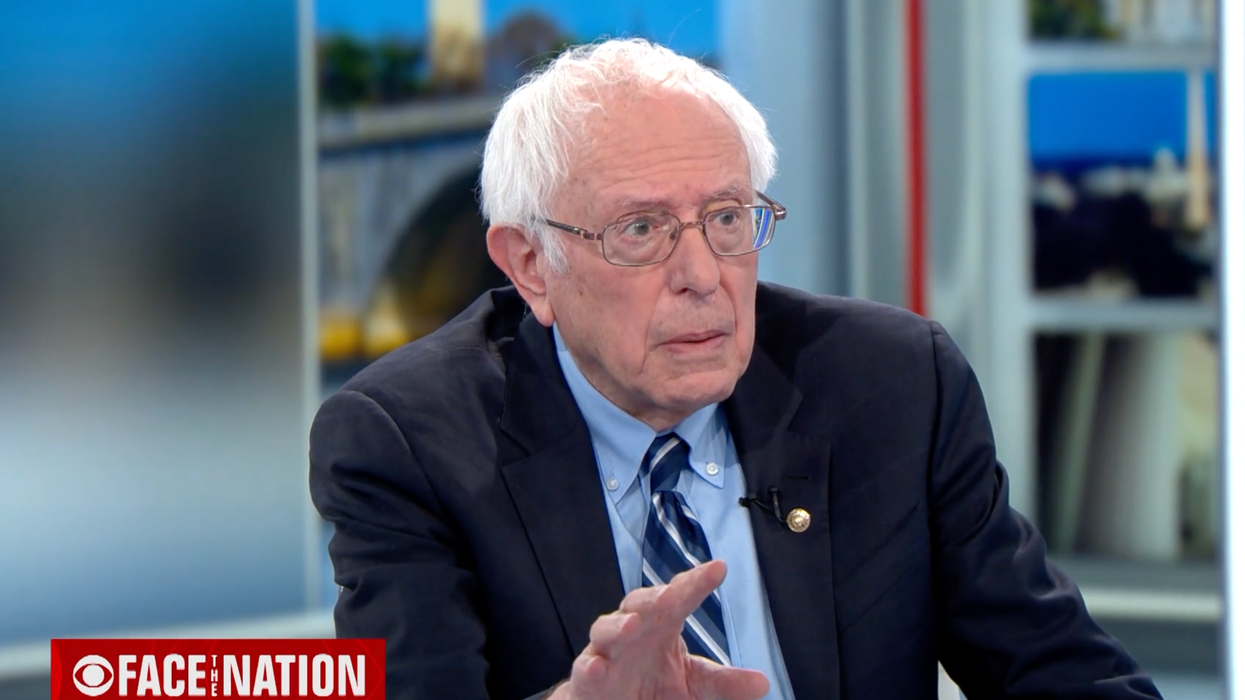
Appearing on “Face the Nation” on CBS Sunday, U.S. Sen. Bernie Sanders discussed a number of issues he covers in his upcoming book, It’s OK to Be Angry About Capitalism, including his proposal to ensure the news media acts in the interest of the general public and not wealthy corporations and powerful interest groups.
Host Margaret Brennan described his proposal as “a New Deal for journalism.”
As some European countries do, the Vermont Independent senator said, the U.S. should have “nonpartisan public funding of media” to ensure local news outlets can stay afloat and keep communities informed about “their city council, their school board.”
Such a system would also prevent news networks like CBS from relying on advertising dollars, which Medicare for All advocates have blamed for playing a role in the corporate media’s hostility towards a nationalized healthcare system and other progressive proposals for the public good.
“What I say in the book is that look, I’ve done 1,000 interviews, like I’m doing with you right now,” Sanders told Brennan. “And nobody has ever come up to me, not one reporter—not you, not anybody else—and said, ‘Bernie, why are we spending twice as much on healthcare as any other country and yet we have 85 million uninsured or underinsured?’ How many programs at CBS, NBC, ABC had on why we have a dysfunctional healthcare system? Does that have anything to do with who owns the major networks? ‘Bernie, what are you going to do about income and wealth inequality?’ … ‘Why are billionaires paying an effective tax rate lower than working class people?’ No one asked me those questions.”
As Luke Savage reported at Jacobin following the 2020 presidential election, viewers of the Democratic primary debates weren’t informed by moderators that Medicare for All was supported by a majority of Americans, and ad breaks featured “health insurance and pharmaceutical companies seizing every opportunity to bombard viewers with misleading industry agitprop about the breathtaking wonders of profit-driven healthcare.”
He added:
CNN’s Detroit debate is a case in point; the network was demanding at least $300,000 from companies advertising, with a single thirty-second spot costing an estimated $110,000—and groups like the so-called Partnership for America’s Health Care Future (in practice, a front for various corporate interests), filled out many of the slots. Regardless of how anchors or hosts think about an issue like healthcare, the networks’ basic model essentially precludes meaningful critique of the status quo by design. As long as it persists, don’t expect to see the public interest or popular opinion reflected anywhere on cable TV.
To counter that dynamic, Sanders argued on “Face the Nation,” a New Deal for journalism including publicly funded media is “an idea that we should explore.”
In the interview, the senator spoke about his support for attaching “some strings” to U.S. funding for Israel to help pressure the country to end its human rights abuses against Palestinians.
\u201c.@SenSanders says \u201csome strings\u201d should be attached to the billions in US aid that goes to Israel as he is \u201cworried\u201d about what PM Netanyahu & \u201csome of his allies in government are doing.\u201d\n\n \u201cYou cannot run a racist government\u2026and then come to America and ask for money.\u201d\u201d— Face The Nation (@Face The Nation) 1676823986Sanders also reiterated his call for the Democratic Party to focus on representing the interests of all working people.
“What we need to do is have a movement of Black workers, Latino workers, white workers, gay workers, straight workers, and understand that we’re all in this together,” said Sanders. “I don’t care if you’re living in rural Iowa, where I spent a lot of time, alright, you can’t afford health care, you can’t afford to send your kid to college, or you’re living in San Francisco. So too often we forget about the economic issues that unite us. The vast majority of the people know the pharmaceutical industry is ripping us off. The vast majority of the people understand that we have to improve our educational system. Let’s work on that.”
This post was originally published on Common Dreams.
-
Senators Bernie Sanders (I-Vermont) and Elizabeth Warren (D-Massachusetts) are demanding that Kroger, the U.S.’s largest supermarket brand, address reports of and lawsuits over “systemic and widespread errors” in the company’s payroll system that labor advocates say have opened the door for the company to commit wage theft. The lawmakers say that Kroger’s latest failure to pay workers is part of a…
This post was originally published on Latest – Truthout.
-

How can we measure the work a particular society truly values? Take-home pay can make as good a yardstick as any: The lower an occupation’s compensation, the lower the esteem a society is showing for that occupation.
In the United States, our pay data show, no profession faces a reality that makes this link plainer — and uglier — than teaching.
All sorts of metrics can help us measure the level of our society’s esteem for the teaching profession. Are young people, for instance, interested in becoming teachers? Between 2008 and 2019, teacher ed enrollments in the United States plunged by over a third. Are current teachers feeling valued? Between 2019 and 2022, teacher retirements and resignations rose 40 percent.
But nothing says “esteem” more directly than paychecks, and, by that metric, American society has for years been systematically devaluing the work teachers do. Between 1996 and 2021, the Economic Policy Institute’s Sylvia Allegretto detailed last August, average teacher weekly wages adjusted for inflation rose a miniscule $29. Over the same years, inflation-adjusted weekly wages for other college graduates rose over 15 times faster, up $445.
What has this shortfall in overall compensation and esteem meant for America’s schools? In the current school year, the U.S. Department of Education reports, every single state in the union has reported teacher shortages, with 46 states citing shortages of science teachers and 44 missing math teachers.
Overall, some 36,000 teaching positions nationwide are going vacant, with at least 163,000 additional positions getting “filled” with unqualified teachers. Both these numbers, concludes a study by researchers at Brown University’s Annenberg Institute, represent “conservative estimates of the extent of teacher shortages nationally.”
Some observers of our contemporary education scene are contending, Stanford’s Linda Darling-Hammond noted last month, that the teacher resignations and vacancies we’re experiencing shouldn’t particularly concern us because they appear mostly in certain subjects and parts of the country. But that amounts to arguing, Darling-Hammond observes, that a house isn’t on fire “because only three of its five rooms are burning.”
Our educational house most definitely is burning, U.S. Senator Bernie Sanders told a town hall on America’s teacher pay crisis at the U.S. Capitol earlier this week.
“I want the day to come, sooner than later, when we are going to attract the best and brightest young people in our country into teaching,” said Sanders. “I want those young people to be proud of the profession that they have chosen.”
All teachers, the Vermont senator believes, should be earning at least $60,000 a year. Some 43 percent of teachers currently fall short of that mark. In Florida, the average teacher earns less than $50,000, just $49,583.
How do the bargain-basement paychecks that go to teachers compare with compensation for other professions? Not well at all. In Florida, accountants make $76,320 annually, 54 percent more than teachers. And software developers in Florida average $105,200, 112 percent more.
But the most stunning pay contrasts show up when we contrast teacher pay to the compensation of our nation’s most generously rewarded power suits.
“The top 15 hedge fund managers on Wall Street,” notes Senator Sanders, “make more money in a single year than every kindergarten teacher in America — over 120,000 teachers.”
Sanders will soon be introducing legislation, the Pay Teachers Act, to ensure that all teachers make at least $60,000 annually and guarantee significantly higher pay for educators “who have made teaching their profession — working on the job for 10, 20, 30 years.”
Where could the funding for this teacher pay revolution come from? From a tax revolution.
Public schools across the nation have historically relied on the local property taxes that average Americans pay. Property taxes today are still supplying 40 percent of total public education funding. These taxes all fall on the primary source of wealth for average families, the owner-occupied home. But America’s rich hold most of their wealth in financial instruments, a category of wealth that essentially goes untaxed, even after death, since the current federal estate tax asks so little from families sitting on grand fortunes.
Senator Sanders has proposed a fix: a thorough-going reform of the federal estate tax. Rich married couples last year could exempt $23.4 million of their fortunes from all estate tax and pay no more than a 40 percent tax on any dollar of wealth above that. The Sanders legislation — the “For the 99.5 Percent Act” — would lower that estate tax exemption to $7 million per married couple and up the minimal estate tax rate on wealth above that level to 45 percent.
Wealthier estates would face even higher rates, with wealth over $1 billion facing a 65 percent estate tax.
The Sanders legislation also takes aim at current loopholes that lower the rate of estate tax that the families of dead deep pockets actually face. Over his legislation’s first 10 years, Senator Sanders notes, the federal treasury would collect an additional $450 billion in estate tax revenue, “precisely how much the Teacher Pay Act would cost.”
“Let’s be clear,” the senator added at the U.S. Capitol teacher pay town hall Monday. “If we can provide over a trillion dollars in tax breaks to the top 1 percent and large corporations, please don’t tell me that we cannot afford to make sure that every teacher in America is paid at least $60,000 a year.”



